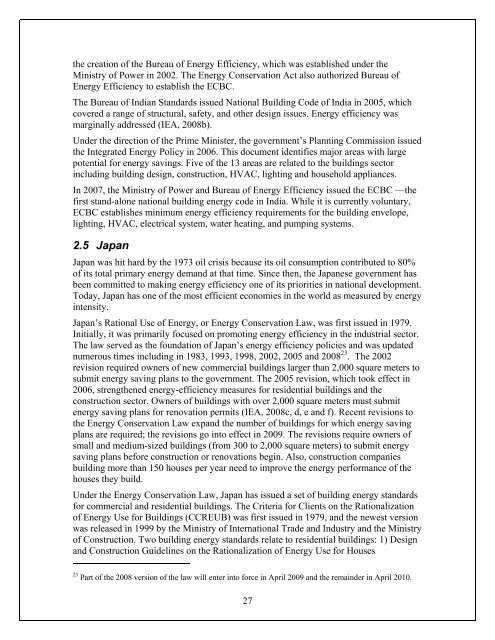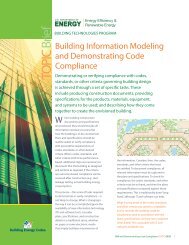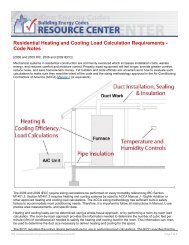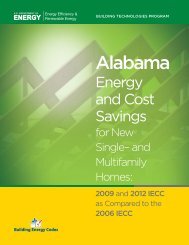Shaping the Energy Efficiency in New Buildings - Building Energy ...
Shaping the Energy Efficiency in New Buildings - Building Energy ...
Shaping the Energy Efficiency in New Buildings - Building Energy ...
Create successful ePaper yourself
Turn your PDF publications into a flip-book with our unique Google optimized e-Paper software.
<strong>the</strong> creation of <strong>the</strong> Bureau of <strong>Energy</strong> <strong>Efficiency</strong>, which was established under <strong>the</strong>M<strong>in</strong>istry of Power <strong>in</strong> 2002. The <strong>Energy</strong> Conservation Act also authorized Bureau of<strong>Energy</strong> <strong>Efficiency</strong> to establish <strong>the</strong> ECBC.The Bureau of Indian Standards issued National Build<strong>in</strong>g Code of India <strong>in</strong> 2005, whichcovered a range of structural, safety, and o<strong>the</strong>r design issues. <strong>Energy</strong> efficiency wasmarg<strong>in</strong>ally addressed (IEA, 2008b).Under <strong>the</strong> direction of <strong>the</strong> Prime M<strong>in</strong>ister, <strong>the</strong> government’s Plann<strong>in</strong>g Commission issued<strong>the</strong> Integrated <strong>Energy</strong> Policy <strong>in</strong> 2006. This document identifies major areas with largepotential for energy sav<strong>in</strong>gs. Five of <strong>the</strong> 13 areas are related to <strong>the</strong> build<strong>in</strong>gs sector<strong>in</strong>clud<strong>in</strong>g build<strong>in</strong>g design, construction, HVAC, light<strong>in</strong>g and household appliances.In 2007, <strong>the</strong> M<strong>in</strong>istry of Power and Bureau of <strong>Energy</strong> <strong>Efficiency</strong> issued <strong>the</strong> ECBC —<strong>the</strong>first stand-alone national build<strong>in</strong>g energy code <strong>in</strong> India. While it is currently voluntary,ECBC establishes m<strong>in</strong>imum energy efficiency requirements for <strong>the</strong> build<strong>in</strong>g envelope,light<strong>in</strong>g, HVAC, electrical system, water heat<strong>in</strong>g, and pump<strong>in</strong>g systems.2.5 JapanJapan was hit hard by <strong>the</strong> 1973 oil crisis because its oil consumption contributed to 80%of its total primary energy demand at that time. S<strong>in</strong>ce <strong>the</strong>n, <strong>the</strong> Japanese government hasbeen committed to mak<strong>in</strong>g energy efficiency one of its priorities <strong>in</strong> national development.Today, Japan has one of <strong>the</strong> most efficient economies <strong>in</strong> <strong>the</strong> world as measured by energy<strong>in</strong>tensity.Japan’s Rational Use of <strong>Energy</strong>, or <strong>Energy</strong> Conservation Law, was first issued <strong>in</strong> 1979.Initially, it was primarily focused on promot<strong>in</strong>g energy efficiency <strong>in</strong> <strong>the</strong> <strong>in</strong>dustrial sector.The law served as <strong>the</strong> foundation of Japan’s energy efficiency policies and was updatednumerous times <strong>in</strong>clud<strong>in</strong>g <strong>in</strong> 1983, 1993, 1998, 2002, 2005 and 2008 23 . The 2002revision required owners of new commercial build<strong>in</strong>gs larger than 2,000 square meters tosubmit energy sav<strong>in</strong>g plans to <strong>the</strong> government. The 2005 revision, which took effect <strong>in</strong>2006, streng<strong>the</strong>ned energy-efficiency measures for residential build<strong>in</strong>gs and <strong>the</strong>construction sector. Owners of build<strong>in</strong>gs with over 2,000 square meters must submitenergy sav<strong>in</strong>g plans for renovation permits (IEA, 2008c, d, e and f). Recent revisions to<strong>the</strong> <strong>Energy</strong> Conservation Law expand <strong>the</strong> number of build<strong>in</strong>gs for which energy sav<strong>in</strong>gplans are required; <strong>the</strong> revisions go <strong>in</strong>to effect <strong>in</strong> 2009. The revisions require owners ofsmall and medium-sized build<strong>in</strong>gs (from 300 to 2,000 square meters) to submit energysav<strong>in</strong>g plans before construction or renovations beg<strong>in</strong>. Also, construction companiesbuild<strong>in</strong>g more than 150 houses per year need to improve <strong>the</strong> energy performance of <strong>the</strong>houses <strong>the</strong>y build.Under <strong>the</strong> <strong>Energy</strong> Conservation Law, Japan has issued a set of build<strong>in</strong>g energy standardsfor commercial and residential build<strong>in</strong>gs. The Criteria for Clients on <strong>the</strong> Rationalizationof <strong>Energy</strong> Use for Build<strong>in</strong>gs (CCREUB) was first issued <strong>in</strong> 1979, and <strong>the</strong> newest versionwas released <strong>in</strong> 1999 by <strong>the</strong> M<strong>in</strong>istry of International Trade and Industry and <strong>the</strong> M<strong>in</strong>istryof Construction. Two build<strong>in</strong>g energy standards relate to residential build<strong>in</strong>gs: 1) Designand Construction Guidel<strong>in</strong>es on <strong>the</strong> Rationalization of <strong>Energy</strong> Use for Houses23 Part of <strong>the</strong> 2008 version of <strong>the</strong> law will enter <strong>in</strong>to force <strong>in</strong> April 2009 and <strong>the</strong> rema<strong>in</strong>der <strong>in</strong> April 2010.27
















